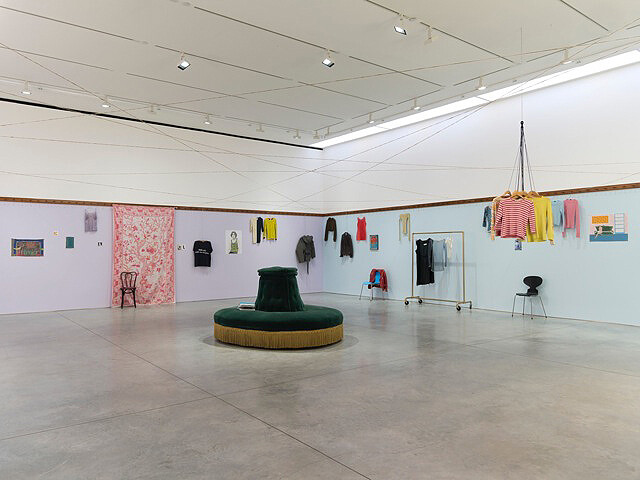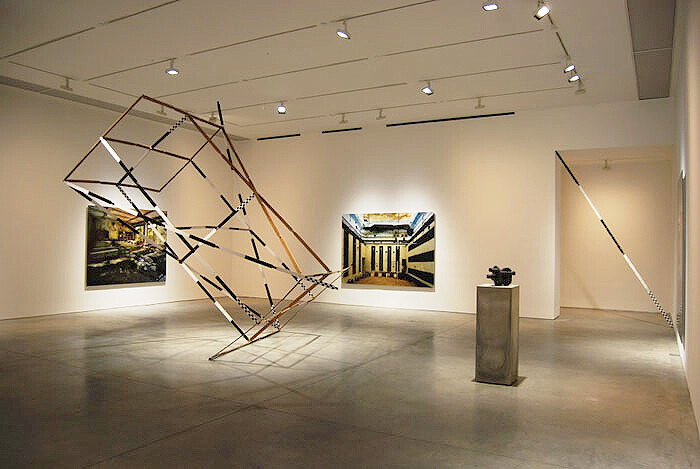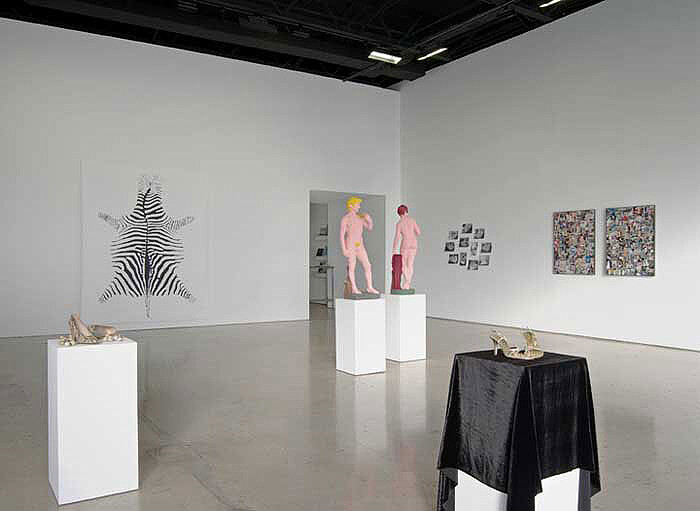Categories
Subjects
Authors
Artists
Venues
Locations
Calendar
Filter
Done
May 21, 2014 – Review
Dominique Gonzalez-Foerster’s “euqinimod & costumes”
Media Farzin

I puzzled over the word “euqinimod” in the exhibition’s title for some time, until I figured out that it’s the artist’s name spelled backwards. And for viewers familiar with Dominique Gonzalez-Foerster’s work of the past two decades, the show does seem like an inversion of her typical approach, and an unusual statement for her first solo exhibition in a US gallery. She is mainly known to New York audiences for her elaborate installations, like chronotopes & dioramas (2009), a project that the Dia Art Foundation commissioned for The Hispanic Society of America, or the performance-concerts NY.2022 (2008) and T.1912 (2011) at the Guggenheim Museum. Gonzalez-Foerster’s signature style is to supply her audience with a minimally furnished stage and invite the viewer’s participation with props, which are often books on subjects that inspire her thinking, from “tropical modernism” to experimental science fiction.
While “euqinimod & costumes” does include a roomy couch and reading material, it feels detached from Gonzalez-Foerster’s larger body of work. It is essentially an installation of her clothes, interspersed with memorabilia like snapshots, childhood drawings, domestic furnishings, and even a painting by her aunt. Strains of Richard Wagner’s 1845 Tannhäuser opera waft out from a smaller back room, a …
July 22, 2013 – Review
Jane and Louise Wilson
Media Farzin

For over two decades, British artists (and sisters) Jane and Louise Wilson have meticulously documented the architectural ruins of twentieth-century modernity. In specific, their focus has been directed towards the dire fate of obsolete military-industrial constellations. Like many artists coming of age after the collapse of the Soviet bloc, their work seems irresistibly drawn to the decaying skeletons of modernist utopias. They sift through debris to uncover present-day resonances that also happen to produce eerily beautiful photographs, films, and installations. Their current exhibition at 303 Gallery shows that the subject still holds their attention while making a compelling case that it should also hold ours.
The works on view are culled from two recent projects, and their undifferentiated installation in one gallery emphasizes an ongoing engagement with the history of Cold War nuclear ambitions and socialist utopianism. The recurring motif here is the yardstick—discreetly included in each of the seven large photographs on view, and reappearing as actual yardsticks in the gallery: some reaching from floor to ceiling in a corner, others stretching diagonally across a doorway, and finally as a large geometric sculpture in the center of the room.
One set of photographs is from the series “Atomgrad, Nature Abhors a …
April 7, 2012 – Review
Hans-Peter Feldmann
Alan Gilbert

Conceptual art has long had a reputation for being a bit dispassionate and cerebral, but recent curatorial and scholarly approaches have emphasized its more human and even emotional sides. Bas Jan Ader’s 16mm, silent film I’m Too Sad to Tell You (1971) is somewhat of a lynchpin work in this respect. A three-and-a-half-minute, black-and-white close-up of the artist weeping, the piece has none of the coolness—except, perhaps, for its lack of a soundtrack—associated with the genre.
There’s a similar warm conceptualism in Hans-Peter Feldmann’s work, and, like the reception of Ader’s art, a period of semi-disappearance and rediscovery. Some of this was self-induced, as when Feldmann stopped making art during the 1980s and later worked fulltime at a gift shop he opened with his wife in his hometown of Düsseldorf. But over the past two decades, Feldmann has produced and exhibited extensively again, culminating with his 2010 selection for the Hugo Boss Prize. For his accompanying solo exhibition at the Guggenheim Museum in New York City, he installed the $100,000 award money in $1 bills lining a gallery adjacent to the main rotunda.
But if a seriality of the mundane is at the heart of Feldmann’s work, the culminating result occasionally signals …
